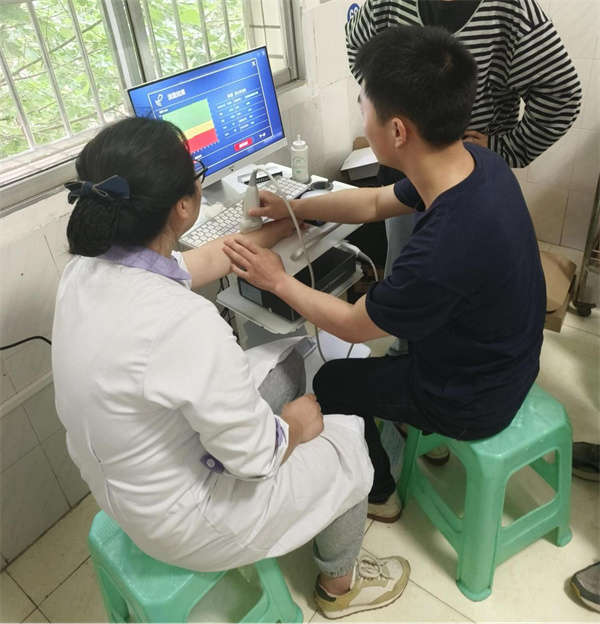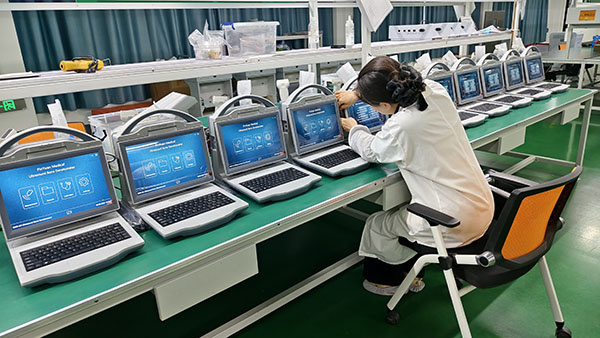In today’s society, with the intensification of population aging, osteoporosis has become an important public health issue.
According to statistics, an osteoporotic fracture occurs every three seconds worldwide. Among them, one third of women and one fifth of men may suffer an osteoporotic fracture after the age of 50.
Therefore, understanding and attaching importance to bone density tests is of great significance for the prevention and treatment of osteoporosis.
01 What is a bone density test?
Bone density, also known as bone mineral density, refers to the amount of minerals contained in a unit volume or unit area of bone tissue. It is an important indicator for assessing bone health.
Bone density tests, by measuring the mineral density of human bones, can reflect the degree of osteoporosis, predict the risk of fractures, and serve as an important basis for diagnosing osteoporosis and evaluating the effectiveness of bone treatment.
02 The Significance of bone density examination
The main purpose of bone density examination is to assess the health status of bones and detect whether there is osteoporosis or other bone diseases.
By measuring bone density, doctors can understand the patient’s bone condition and formulate corresponding treatment plans.
Bone density tests not only help to detect osteoporosis at an early stage, but also predict the risk of fractures, providing a scientific basis for patients’ health management.
03 Applicable Population
Bone density tests are suitable for women and men of all ages, especially those over 50 years old, as well as those with the following risk factors:
Perimenopausal or postmenopausal women
Long-term smokers and alcoholics
Those who consume excessive amounts of coffee and carbonated beverages
Improper dieters for weight loss
People lacking calcium and vitamin D in their diet
Those who have been bedridden for a long time
Those with a history of fragility fractures or a family history of the disease
People with low levels of sex hormones caused by various reasons
Those whose X-rays show changes in osteoporosis
And those who suffer from diseases that affect bone mineral metabolism (such as rheumatic diseases, renal insufficiency, diabetes, etc.) or have been taking drugs that may affect bone mineral metabolism for a long time (such as glucocorticoids, antiepileptic drugs, etc.).
04 Inspection Methods
The commonly used methods for bone density examination at present include:
Dual-energy X-ray absorption assay (DXA)
It is currently the internationally recognized standard method for bone mineral density measurement, featuring high precision, small error and high diagnostic rate. DXA can measure bone density in any part of the body, especially in the lumbar vertebrae and hip, and is the preferred method for assessing the degree of osteoporosis and guiding treatment.
Ultrasonic measurement method
The conditions of bone mineral content and bone strength are reflected by using the speed of sound wave conduction and amplitude attenuation. The operation is simple, safe and harmless, and the price is low, but the accuracy is relatively low.
In today’s society, with the intensification of population aging, osteoporosis has become an important public health issue.
According to statistics, an osteoporotic fracture occurs every three seconds worldwide. Among them, one third of women and one fifth of men may suffer an osteoporotic fracture after the age of 50.
Therefore, understanding and attaching importance to bone density tests is of great significance for the prevention and treatment of osteoporosis.
01 What is a bone density test?
Bone density, also known as bone mineral density, refers to the amount of minerals contained in a unit volume or unit area of bone tissue. It is an important indicator for assessing bone health.
Bone density tests, by measuring the mineral density of human bones, can reflect the degree of osteoporosis, predict the risk of fractures, and serve as an important basis for diagnosing osteoporosis and evaluating the effectiveness of bone treatment.
02 The Significance of bone density examination
The main purpose of bone density examination is to assess the health status of bones and detect whether there is osteoporosis or other bone diseases.
By measuring bone density, doctors can understand the patient’s bone condition and formulate corresponding treatment plans.
Bone density tests not only help to detect osteoporosis at an early stage, but also predict the risk of fractures, providing a scientific basis for patients’ health management.
03 Applicable Population
Bone density tests are suitable for women and men of all ages, especially those over 50 years old, as well as those with the following risk factors:
Perimenopausal or postmenopausal women
Long-term smokers and alcoholics
Those who consume excessive amounts of coffee and carbonated beverages
Improper dieters for weight loss
People lacking calcium and vitamin D in their diet
Those who have been bedridden for a long time
Those with a history of fragility fractures or a family history of the disease
People with low levels of sex hormones caused by various reasons
Those whose X-rays show changes in osteoporosis
And those who suffer from diseases that affect bone mineral metabolism (such as rheumatic diseases, renal insufficiency, diabetes, etc.) or have been taking drugs that may affect bone mineral metabolism for a long time (such as glucocorticoids, antiepileptic drugs, etc.).
04 Inspection Methods
The commonly used methods for bone density examination at present include:
Dual-energy X-ray absorption assay (DXA)
It is currently the internationally recognized standard method for bone mineral density measurement, featuring high precision, small error and high diagnostic rate. DXA can measure bone density in any part of the body, especially in the lumbar vertebrae and hip, and is the preferred method for assessing the degree of osteoporosis and guiding treatment.
Ultrasonic measurement method
The conditions of bone mineral content and bone strength are reflected by using the speed of sound wave conduction and amplitude attenuation. The operation is simple, safe and harmless, and the price is low, but the accuracy is relatively low.
Post time: May-21-2025


